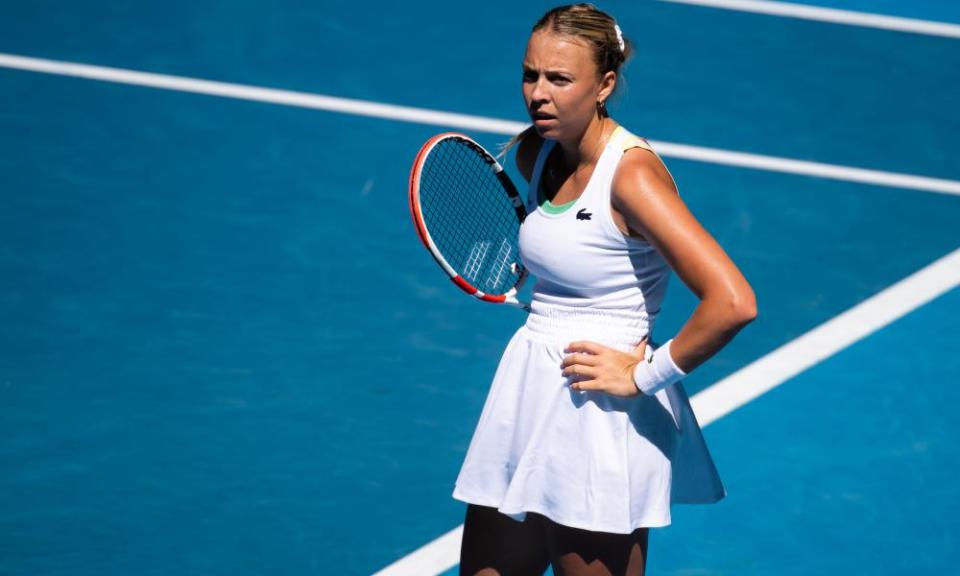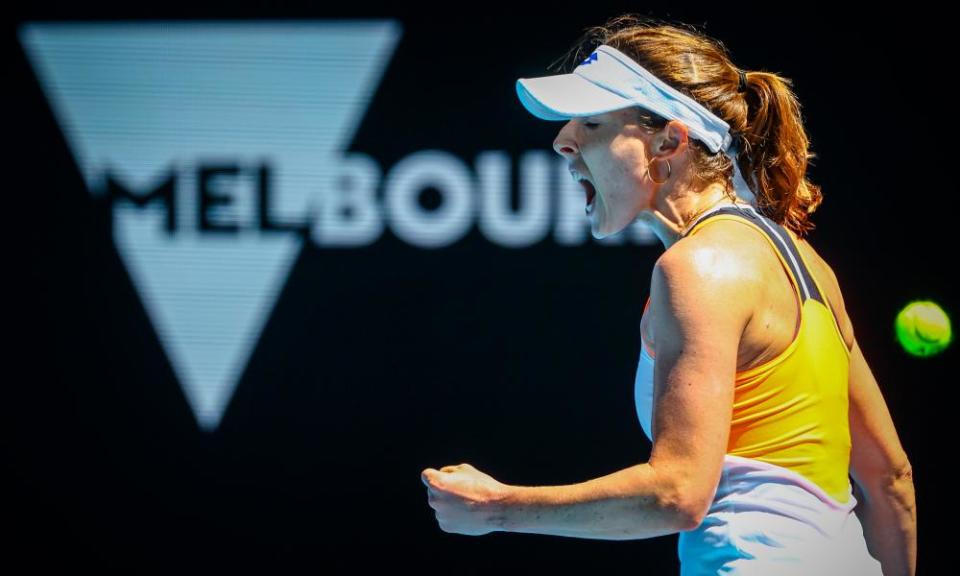Sabalenka survives despite service disruption but Kontaveit crashes out

As Aryna Sabalenka stepped up to the baseline for her Australian Open second-round match against Wang Xiynu of China, it did not take her long to realise this would be yet another day without her serve.
The double faults came immediately and with great variety: slightly long, barely wide, back fence, photo pit. She served six in her opening service game and she had nine after her second. So predictable were her troubles, the stats keepers were ready: at one point in the first set Sabalenka had attempted 117 second serves in 2022; 57 had ended in a double fault.
Related: ‘I couldn’t have asked for more’: Sam Stosur finally bows out as Australian tennis great
In the first weeks of the new season, Sabalenka’s serving woes have been one of the most curious storylines. Her high-risk game has always naturally yielded a high number of errors, but in the final weeks of last season, she completely lost control. She ended her 2021 campaign with a miserable series of serving performances – and losses – at the WTA Finals. In her first two matches of this season, both losses, she served a combined 38 double faults.
And yet, on a day of upsets in the women’s draw, and in front of an ambitious young player in search of a career best win, Sabalenka defeated Wang 1-6, 6-4, 6-2 to reach the third round.
Last year, Sabalenka’s success was one of the defining aspects of the season. She won two titles, made numerous deep runs and then reached her first two grand slam semi-finals at Wimbledon and the US Open. Although she has learned to harness her power and register consistent results, demolishing the ball remains her modus operandi. It was effective enough for her to finish the season with a career high ranking of No 2 in the world.
In recent matches, Sabalenka had allowed her service issues to consume her. She spent her first-round loss in Adelaide resorting to anguished underarm serves and gesturing to her team. But here, she simply focused on executing all of the other aspects of her game that continue to thrive.
“I already had a lot of experience playing without a serve,” she said. “I just kept telling myself: ‘You have enough shots to still win the match even if you cannot serve.’ So I think this kind of mentality helped me to stay in the game and actually find my serve.”

As she pushed on, Sabalenka did slowly find rhythm. By the end of the third set she was obliterating her second serve, its average speed rising from 91mph to an enormous 103mph in the third set and winning points by itself. Of her 19 double faults in the match, 12 came in the blowout first set. She landed a 101mph second-serve ace in the final game for good measure.
In the third round, Sabalenka will face Marketa Vondrousova, the 31st seed. She had the resilience to push on and maintain her spot in the draw and on Saturday she will have another opportunity to rediscover her best tennis.
While Sabalenka survived, Thursday saw the bottom half of the women’s draw ransacked in five short minutes after two tournament favourites were scuppered. Clara Tauson, a 19-year-old former Australian Open girls’ champion, rose to produce the best match of her young career against one of the in-form players in the women’s game, defeating the sixth seed Anett Kontaveit 6-2, 6-4.
Tauson stands at 6ft, she already has one of the heaviest forehands in the game and she spent the match dictating from the baseline. As Kontaveit tried to avoid Tauson’s forehand, the Dane showed her attacking potential on both wings by simply dismantling the Estonian with her searing, flat backhand. “Today we had a plan that I didn’t really follow because I felt really good out there, so I went for everything in my shots,” she said, smiling.
As Kontaveit departed the court in defeat, Garbiñe Muguruza was also on the brink. Rather than a fearless young upstart, she fell 6-3, 6-3 to Alize Cornet, a French veteran who has been a fixture at the top of the sport over the past decade and half.

Cornet has now played 60 consecutive grand slam tournaments since January 2007, two appearances shy of the women’s record held by Ai Sugiyama, and on her 32nd birthday against Muguruza she pulled off one of the best victories of her career. Afterwards, she revealed she was not sure if she would continue after this year.
“Sometimes you lose, for example, with match point,” she said. “You go back to your hotel room and you go: ‘What’s the point of doing all that?’ This is not an easy job. You’re on the road basically 10 months out of 12 so you never see your family, it’s really hard to have a love life. All these things around tennis make it complicated. But the love of the game has always been stronger.”
For Cornet, her lack of certainty about her future formed part of her motivation as she entered Rod Laver Arena on Thursday morning and defeated a top five player at a grand slam tournament for just the second time in her life.
“I think today the key was that I’m telling myself that I’m playing probably my last year. I’m not sure yet. When I stepped on the court, I was like: ‘You know what? Just enjoy the moment because you don’t know if you’re going to come back.’ I think that’s what made the difference.”

 Yahoo Movies
Yahoo Movies 
